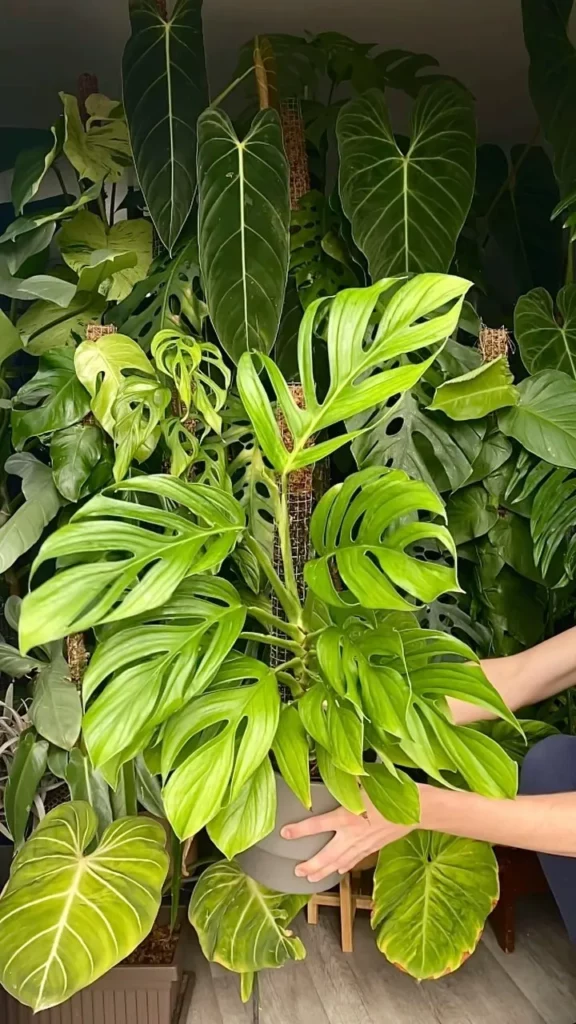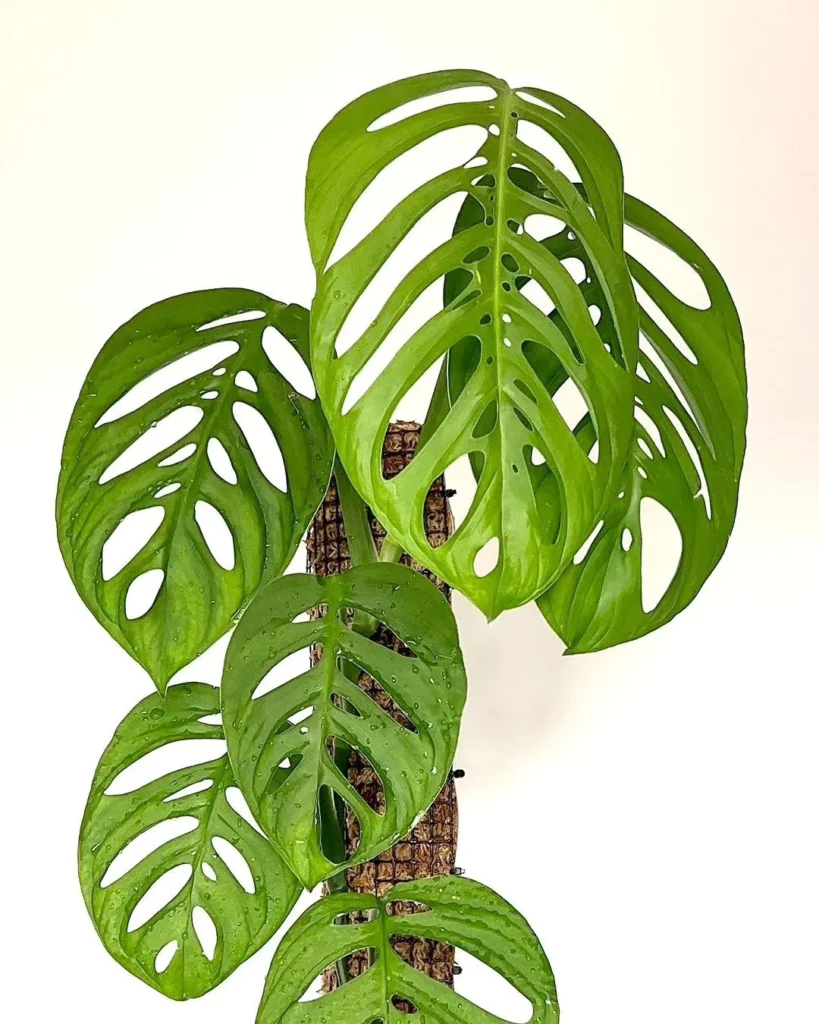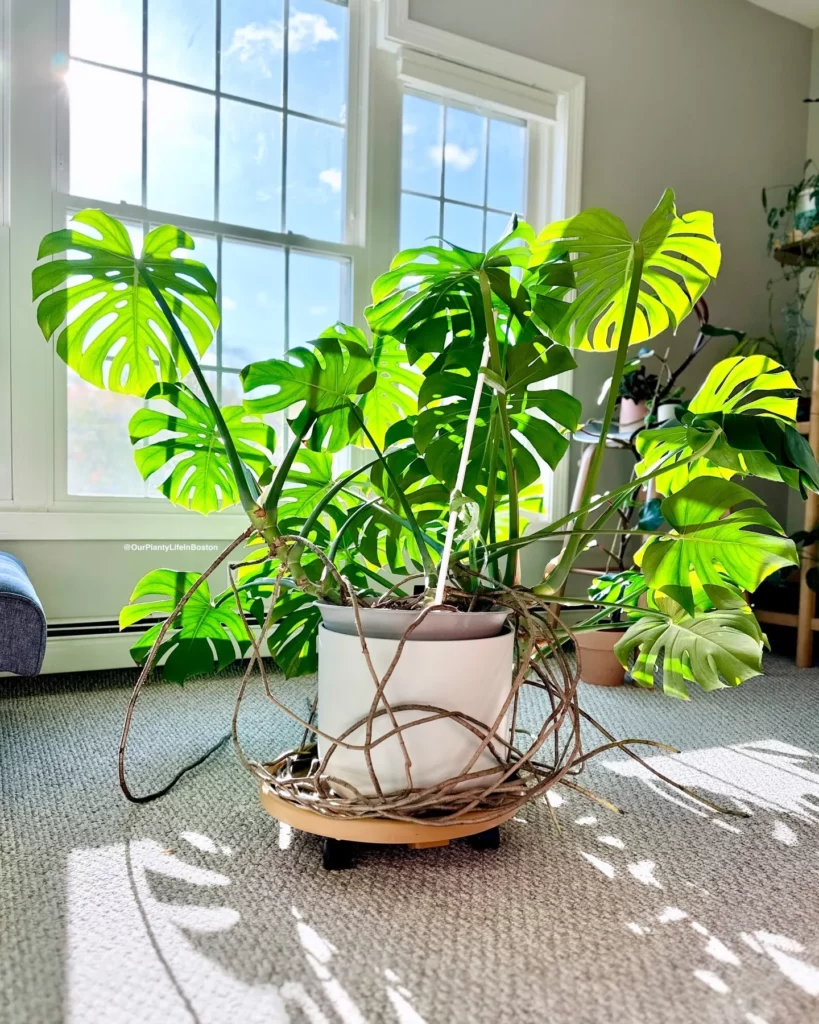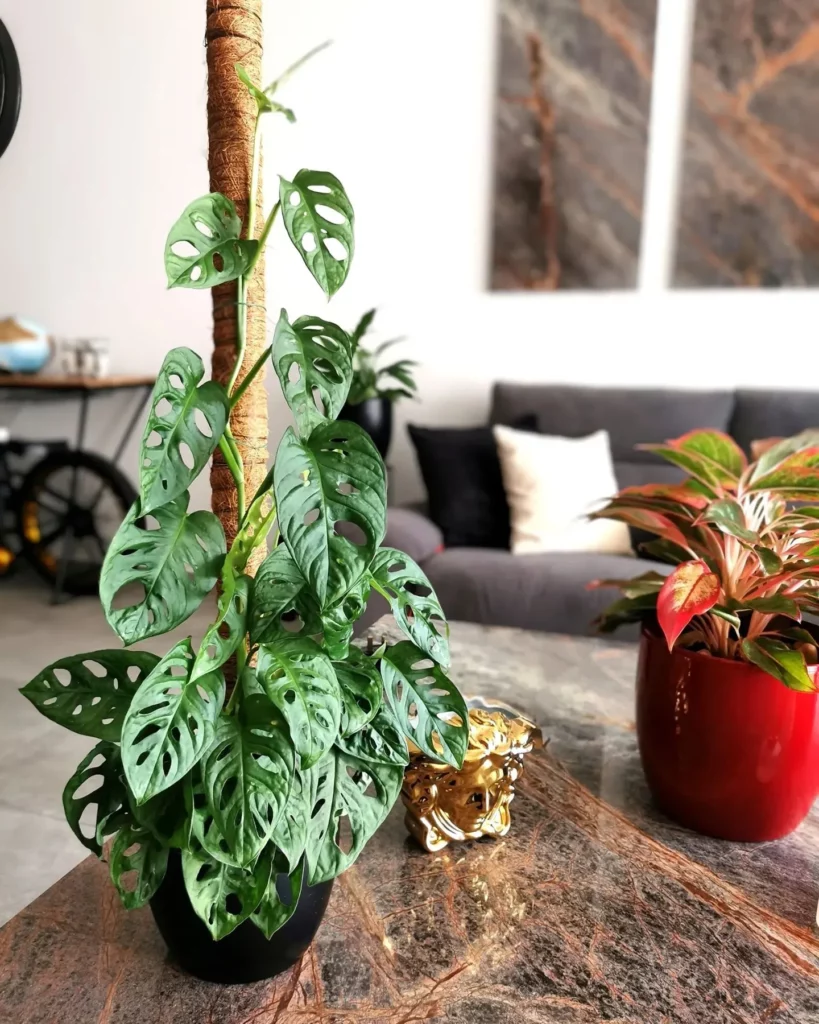It’s official: Monstera is the Plant of Year 2024.
In the world of interior design and gardening, trends come and go, but some plants manage to steal the spotlight and hold onto it for an extended period.
In recent years, there’s been an undeniable surge in the popularity of one such houseplant – the Monstera. Often referred to as the “Swiss Cheese Plant” due to its distinctive leaf pattern, the Monstera has become the hottest houseplant trend of the year. In this blog, we will delve into the Monstera madness, exploring what makes this plant so special, how to care for it, creative ways to display it, and why it’s the go-to choice for both beginners and seasoned plant enthusiasts.



A Monstera Story
In a grand New York mansion, I met Margaret, a true plant enthusiast, who graciously welcomed me into her home. As I entered the elegant foyer, my attention was immediately drawn to an impressive Monstera deliciosa.
Margaret’s mansion was adorned with antiques and thriving houseplants, but the Monstera stood out with its striking fenestrated leaves, cascading from a well-crafted planter. This plant had been in Margaret’s care for nearly a decade.
Margaret explained that she received a small cutting of the Monstera from a friend and watched it grow over the years. She found taking care of it therapeutic and a break from the outside world.
Over tea, Margaret shared her Monstera care tips, emphasizing the right balance of light, humidity, and watering. She recommended allowing the soil to dry slightly between waterings and wiping dust off the leaves.
Our conversation extended to houseplants in general and their positive impact on well-being. Margaret believed that her plants, especially the Monstera, added beauty and tranquility to her home.
As our meeting concluded, Margaret kindly gave me a Monstera cutting as a keepsake. I left her mansion, reflecting on how plants can bring solace and connection into our lives. Margaret’s story is a reminder of the power of nature to inspire and provide moments of beauty in our busy lives.

The Appeal of the Monstera
Before we dive into the care and styling aspects of Monstera plants, let’s understand why these tropical beauties have captured the hearts of plant lovers worldwide.
- Unique Leaf Design: The Monstera’s most distinguishing feature is its fenestrated leaves, which resemble Swiss cheese with holes and splits. This unique pattern adds a touch of exotic charm to any room.
- Low Maintenance: Monstera plants are relatively easy to care for, making them an excellent choice for both beginners and experienced plant parents. They can adapt to a variety of light conditions and are forgiving when it comes to watering.
- Air-Purifying Qualities: Like many other houseplants, Monstera plants contribute to better indoor air quality by filtering out toxins and releasing oxygen, creating a healthier living environment.
- Versatile Aesthetic: Whether your home décor leans towards boho, modern, or traditional, the Monstera fits seamlessly into a wide range of interior styles, adding a tropical touch to any space.
- Propagating Potential: Monstera enthusiasts love propagating these plants, creating new growth from cuttings. This process not only multiplies your Monstera collection but also adds an exciting element to plant care.
Now that we understand why Monstera is in such high demand, let’s explore how to care for these stunning houseplants.
Caring for Monstera Plants
Monstera plants are known for their adaptability and resilience, making them an ideal choice for plant enthusiasts of all skill levels.
No products found.
Here’s a comprehensive guide on how to care for your Monstera:
1. Light Requirements: Monstera plants thrive in bright, indirect sunlight. Avoid direct sun exposure, as it can scorch their leaves. A few feet away from a sunny window is perfect.
2. Watering: Allow the top inch of the soil to dry out between waterings. Monstera prefers consistently moist but not soggy soil. Overwatering can lead to root rot.
3. Humidity: Monstera plants appreciate higher humidity levels. Regular misting or using a humidity tray can help mimic their tropical environment.
4. Temperature: Keep your Monstera in a room with temperatures between 65°F to 80°F (18°C to 27°C). Avoid exposing them to cold drafts.
5. Balanced Fertilizer: Feed your Monstera with a balanced, water-soluble fertilizer during the growing season (spring and summer) every 2-4 weeks.
6. Regular Pruning: Trim away yellow or damaged leaves to encourage healthy growth. Pruning can also help manage the size and shape of your Monstera.
7. Repot When Necessary: Monstera plants don’t require frequent repotting. Repot when you notice the roots are becoming root-bound or the soil has depleted its nutrients.
8. Provide Support: As Monstera plants grow, they may benefit from a moss pole or trellis to support their climbing tendencies.



Styling with Monstera
Monstera’s lush, tropical appearance allows for various creative styling options in your home. Here are some exciting ways to incorporate Monstera plants into your décor:
- Statement Piece: Make your Monstera the focal point of a room by placing it in an elegant pot and positioning it in a well-lit corner.
- Hanging Beauty: Hang your Monstera in a decorative planter to create a stunning cascading effect that adds dimension to your space.
- Group Planting: Create a lush indoor jungle by grouping Monstera plants of different sizes together.
- Corner Companion: Utilize empty corners by placing a tall Monstera next to a chair or table to add a touch of greenery.
- Monstera Wall: Display several Monstera cuttings in wall-mounted propagation stations for a unique, living wall art piece.
- Terrarium Charm: Incorporate small Monstera cuttings into terrariums or glass jars for a mini tropical garden.
Monstera Madness Beyond Your Home
Monstera madness isn’t limited to personal spaces. It has also found its way into the world of weddings and events. Event planners and couples are embracing Monstera plants for their weddings, adding a touch of natural elegance to the décor. From table centerpieces to bouquets, Monstera leaves have become a symbol of love and growth.






Can cats and monstera get along?
Cats and Monstera plants can coexist, but it’s important to be aware of some considerations to ensure the well-being of both your cat and your Monstera:
Toxicity: Monstera deliciosa, like many houseplants, is considered toxic to cats if ingested. The plant contains compounds that can cause gastrointestinal upset, including vomiting, drooling, and diarrhea, if consumed in large quantities. Some cats may be attracted to the plant’s leaves and might try to chew on them. To prevent this, it’s a good idea to place your Monstera out of your cat’s reach or use deterrents like bitter sprays to discourage them from nibbling on the leaves.
Supervision: Keep an eye on your cat when it’s near your Monstera, especially if your cat is known to be curious or prone to chewing on plants. Providing alternative cat-friendly plants or toys can help divert their attention away from your Monstera.
Plant placement: Elevate your Monstera or place it in a spot where your cat can’t easily access it. Hanging your Monstera in a macramé hanger, for example, can be an effective way to keep it out of reach.
Training and redirection: If your cat shows interest in your Monstera, you can use positive reinforcement techniques to train them to avoid it. Offering treats and praise when they stay away from the plant can help deter them.
Cat-safe alternatives: If you’re concerned about your Monstera’s safety or your cat’s tendency to chew on plants, consider choosing non-toxic houseplants or creating a designated cat-safe area in your home with plants that are safe for cats.
My Favorite Plant Monster Delicioso! I have two and they are huge. It completes my collection. Am retired and disabled so this plsnt especially gives me the strength to keep going. I sing to it shower it and play plant music. Yes its about me and my plantlife101.
I understand perfect.
This my life I share with my plants , I talking and play music for then .I have my first Monstera for a year now even I have a very small place but I’m happy to share with then.and the very cold nigth and hot days.
Make me happy.
It’s wonderful to hear how much joy your plants bring to your life! Taking care of and nurturing plants can be a fulfilling and therapeutic hobby. Your Monstera and other green companions will thrive with your care, and the bond you form with them can be truly special. Keep talking to them and playing music – it’s not only enjoyable for you but can also contribute positively to their growth. Your dedication to your plants is admirable, and they are lucky to have such a caring plant parent. Happy gardening!
Is a monstera plant the same as a large split leaf philodendron?
Monstera deliciosa and split-leaf philodendron (Philodendron bipinnatifidum) are two different plant species, although they do share some similarities in appearance, which can sometimes lead to confusion between the two.
Monstera deliciosa, commonly known as the Swiss cheese plant, is a tropical vine native to Central America. It is known for its distinctive split leaves with irregular holes, which give it the appearance of Swiss cheese, and it’s a popular houseplant due to its unique look and relatively easy care.
Split-leaf philodendron (Philodendron bipinnatifidum), on the other hand, is also known for its large, split leaves but belongs to the genus Philodendron, not Monstera. It is native to South America and is sometimes referred to as the tree philodendron or cut-leaf philodendron. This plant is also commonly grown as a houseplant.
While both Monstera deliciosa and split-leaf philodendron have similar-looking leaves, they are distinct species with their own characteristics. Monstera leaves often have more pronounced splits and holes compared to the split-leaf philodendron, and the two plants may differ in their growth habits, care requirements, and other features. It’s important to correctly identify the plant you have to provide the appropriate care and maintenance.
What about if the leaf does not open up all the way? I think I mean the leaves curls up on one side of the leaf ? Is it over water or not enough water ?
Does your adult leaves on the Monstera show tiny water droplets a day later when you water them? If so, then the plant is well-watered. What is your water-schedule?
I have 4 Monsteras in my home (my all-time favorite plant!! 1 died, so I put the 2 smaller ones in a big container where they have plenty of root growth), but one has really droopy leaves!! Why is that and what can I do about it?
Droopy Monstera leaves can be caused by overwatering, underwatering, or inadequate light. Check the soil moisture by sticking your finger into the soil; water when the top inch feels dry, and ensure good drainage in the pot. Place your Monstera in a location with bright, indirect sunlight to promote healthy growth and prevent drooping leaves.
Thank you for all the information. I have to repot Monstera deliciosa. It hasn’t grown in years. I know they need good drainage but do you recommend a clay or plastic pot?
Thank you
I prefer ceramic pots whenever repotting Monstera plants! They can be high quality containers that last for decades and help the growth of the Monstera.
How do you divide a monstera plant that has gotten too large for the space and/ or you want to give away a cutting? Is there a particular time of the year to do it? Thanks
To divide a Monstera plant that has become too large or for sharing, choose spring or early summer. Prepare clean, sterile pots with well-draining soil and water the plant a day or two in advance. Use pruning shears or a sharp knife to carefully cut the plant into smaller sections, making sure each section has roots and leaves, and then replant them in their respective containers.
I enjoyed your replies above. My wife and I have a small nursery here in SW Georgia. I, also, do some plant rehab for some of our friends and customers who have been less than diligent in plant care for whatever reason. I generally only charge for supplies used unless they are repeat offenders.
We do programs in schools when asked as well as for church groups. I teach broad strokes in identifying which plants best suit someone’s lifestyle and will visit homes to suggest new plants or a plant to revitalize an area. I have even done the occasional program on how working with and establishing a relationship with plants have helped me through my PTSD.
I have only worked with plants and nurseries for about seventy years. I started in my parent’s gardens and grandparents farms. Then in my mother’s nursery down in Fort Lauderdale. We sell mostly on Facebook now and at a park here on Saturdays in the summer. People drag their friends down to me on those Saturdays and say, “Now, tell him about what is going on with your plants. He can fix anything with them if they have not been dead more than a week.
I chuckle and say that is hyperbole but I will try to help. I still consider myself a student because there is always something new. I love seeing people walk away informed and having not having to spend any money. I am also happy to sell them plants because my wife and I are not still working because of our financial acumen. We are just old hippies bungling our way through and trying to do a little good along the way.
Michael
Michael, your passion for plants and your dedication to helping others with their green companions are truly inspiring. It’s remarkable to see how you’ve cultivated a lifelong love for plants and are sharing your knowledge and expertise with your community, whether it’s through rehabilitating neglected plants, teaching in schools and churches, or helping people find the right plants for their lifestyles.
I got my first Monstera Delicosa about 6 years ago the borsigiana kind has smaller leaves and climbs rapidly after dealing with albo reversion I decided to get a Thai Constellation. They stay out side in South Florida it can handle cool temperatures it was 42 last night and doesn’t revert. It also will stay more bushy more of a crawler and gets huge leaves. This is the only monstera I really like besides the other species.
It’s great to hear about your experience with Monstera Deliciosa and Thai Constellation in South Florida! The Thai Constellation is indeed a stunning variety with its variegated leaves, and it’s known for its ability to maintain its variegation more consistently compared to some other variegated Monstera varieties. Keeping it outside in a suitable climate can allow it to thrive and develop its unique characteristics, including its large leaves and bushy growth habit. Enjoy your beautiful Thai Constellation Monstera!
Can you bonsai a monstera?
Bonsai is usually reserved for hard-stemmed plants like ficus.
I thought that the monster delicioso was a great plant because of its Delicious fruit it has the best tasting smoothest fruit that you’ll ever imagine with a beautiful yellow flower that surrounds it and protects it. It takes about 2 years to for the fruit to ripen. We nicknamed it dildodendron for the shape of the fruit.